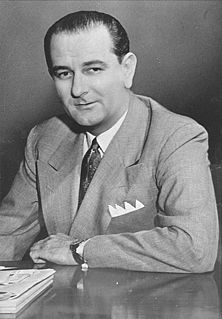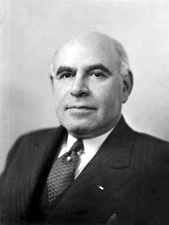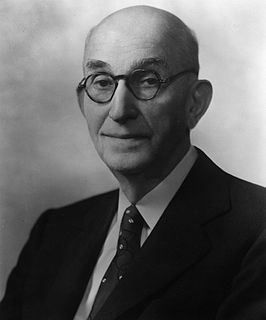
The 1964 United States Senate elections coincided with the election of President Lyndon B. Johnson by an overwhelming majority, to a full term. His Democratic Party picked up a net two seats from the Republicans. As of 2019, this is the last time either party has had a two-thirds majority in the Senate, which would have hypothetically allowed the Senate Democrats to override a veto, convict and expel certain officials, or invoke cloture without any votes from Republicans. The Senate election coincided with Democratic gains in the House in the same year.

The 1956 United States Senate elections were elections for the United States Senate that coincided with the re-election of President Dwight D. Eisenhower. Although the Democrats gained two seats in regular elections, the Republicans gained back two seats in special elections, leaving the party balance of the chamber remained unchanged.

The 1948 United States Senate elections were elections which coincided with the election of Democratic President Harry S. Truman for a full term. Truman had campaigned against an "obstructionist" Congress that had blocked many of his initiatives, and in addition the U.S. economy recovered from the postwar recession of 1946–47 by election day. Thus Truman was rewarded with a Democratic gain of nine seats in the Senate, enough to give them control of the chamber.

The 1946 United States Senate elections were held November 5, 1946, in the middle of Democratic President Harry S. Truman's first term.

The United States Senate elections of 1944 coincided with the re-election of Franklin D. Roosevelt to his fourth term as President. The Democrats' large majority remained the same, but they lost one seat to the Republicans in a special election.

Although the 17th Amendment was not passed until 1913, some states elected their Senators directly before its passage. Oregon pioneered direct election and experimented with different measures over several years until it succeeded in 1907. Soon after, Nebraska followed suit and laid the foundation for other states to adopt measures reflecting the people's will. By 1912, as many as 29 states elected senators either as nominees of their party's primary or in conjunction with a general election.

The 1958 New York state election was held on November 4, 1958, to elect the Governor, the Lieutenant Governor, the State Comptroller, the Attorney General, a judge of the New York Court of Appeals and a U.S. Senator, as well as all members of the New York State Assembly and the New York State Senate.

The 1974 New York state election was held on November 5, 1974, to elect the Governor, the Lieutenant Governor, the State Comptroller, the Attorney General, two judges of the New York Court of Appeals and a U.S. Senator, as well as all members of the New York State Assembly and the New York State Senate.

The 1966 New York state election was held on November 8, 1966, to elect the Governor, the Lieutenant Governor, the State Comptroller, the Attorney General and the Chief Judge of the New York Court of Appeals, as well as all members of the New York State Assembly and the New York State Senate. Besides, 15 delegates-at-large to the New York State Constitutional Convention of 1967 were elected on the state ticket, and three delegates each in the 57 senatorial districts.

The 1962 New York state election was held on November 6, 1962, to elect the Governor, the Lieutenant Governor, the State Comptroller, the Attorney General, a judge of the New York Court of Appeals and a U.S. Senator, as well as all members of the New York State Assembly and the New York State Senate.

The 1950 New York state election was held on November 7, 1950, to elect the Governor, the Lieutenant Governor, the State Comptroller, the Attorney General and a U.S. Senator, as well as all members of the New York State Assembly and the New York State Senate.

The 1946 New York state election was held on November 5, 1946, to elect the Governor, the Lieutenant Governor, the State Comptroller, the Attorney General, a U.S. Senator, the Chief Judge and an associate judge of the New York Court of Appeals, as well as all members of the New York State Assembly and the New York State Senate.

The 1942 New York state election was held on November 3, 1942, to elect the Governor, the Lieutenant Governor, the State Comptroller, the Attorney General and two U.S. Representatives At-large, as well as all members of the New York State Assembly and the New York State Senate.

The 1938 New York state election was held on November 8, 1938, to elect the Governor, the Lieutenant Governor, the State Comptroller, the Attorney General, two U.S. Senators and two U.S Representatives-at-large, as well as all members of the New York State Assembly and the New York State Senate.

The 1936 New York state election was held on November 3, 1936, to elect the Governor, the Lieutenant Governor, the State Comptroller, the Attorney General, a judge of the New York Court of Appeals and two U.S. Representatives-at-large, as well as all members of the New York State Assembly and the New York State Senate.

The 1934 New York state election was held on November 6, 1934, to elect the Governor, the Lieutenant Governor, the State Comptroller, the Attorney General, a U.S. Senator, two U.S. Representatives-at-large, the Chief Judge and two associate judges of the New York Court of Appeals, as well as all members of the New York State Assembly and the New York State Senate.

The 1930 New York state election was held on November 4, 1930, to elect the Governor, the Lieutenant Governor, the State Comptroller, the Attorney General and a judge of the New York Court of Appeals, as well as all members of the New York State Assembly and the New York State Senate.

The 1932 New York state election was held on November 8, 1932, to elect the Governor, the Lieutenant Governor, the State Comptroller, the Attorney General, the Chief Judge, a U.S. Senator and two U.S. Representatives-at-large, as well as all members of the New York State Assembly and the New York State Senate.

The 1940 New York state election was held on November 5, 1940, to elect three judges of the New York Court of Appeals, a U.S. Senator and two U.S Representatives-at-large, as well as all members of the New York State Assembly and the New York State Senate.

The 1944 New York state election was held on November 7, 1944, to elect a judge of the New York Court of Appeals and a U.S. senator, as well as all members of the New York State Assembly and the New York State Senate.




















